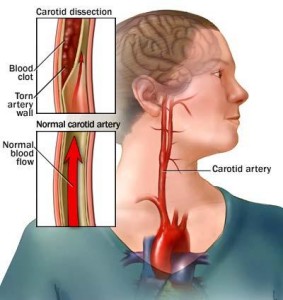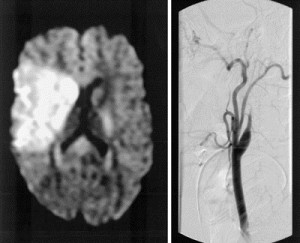General Information
- Carotid dissection is a breakdown of the layers of the carotid artery that causes the wall to tear. The tear may cause stenosis, an irregular narrowing of the opening in the vessel, and occlusion, a flap of the vessel wall protruding into the opening.
- Hyperextension of the neck from turning of the head is a common cause of carotid dissection, as the action can stretch the internal carotid artery over the spinal vertebrae.
- Other traumatic causes include chiropractic manipulation, attempted strangulation and cerebral angiography.
Symptoms
- The most common symptom is headache on the same side as the dissection, usually around the eyes. Other symptoms include severe pain over the carotid artery in the neck, drooping eyelid, small pupils and bruits, or blood flow murmurs audible to the patient.
- Ischemic symptoms, those related to low blood flow through a vessel, include visual loss, weakness, numbness or speech difficulties. These events may be transient ischemic attacks (TIAs) or permanent.
Diagnosis
- Angiography can identify stenosis and occlusion. Magnetic resonance imaging (MRI) can identify a hematoma, or blood clot.
Treatment
- Blood-thinning medication is the primary treatment, first with heparin then with anticoagulants for eight to 12 weeks.
- Additional angiography may be necessary before stopping treatment to ensure the vessel has healed.







